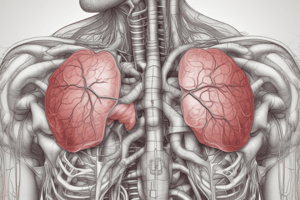Podcast
Questions and Answers
What is the primary mechanism by which obesity affects lung function?
What is the primary mechanism by which obesity affects lung function?
- Reduced lung compliance due to increased chest wall weight
- Decreased respiratory muscle strength
- Organs pushing the diaphragm upward (correct)
- Increased airway resistance due to fat deposition
What is the primary difference between FEV and FVC?
What is the primary difference between FEV and FVC?
- FEV is a measure of airway resistance, while FVC is a measure of lung compliance
- FEV is measured at the beginning of exhalation, while FVC is measured at the end
- FEV is measured over 1 second, while FVC is measured over the entire exhalation (correct)
- FEV is a measure of lung volume, while FVC is a measure of lung pressure
In obstructive lung disease, what is the primary problem with FEV?
In obstructive lung disease, what is the primary problem with FEV?
- Air is not able to escape the lungs quickly enough (correct)
- Air is not able to escape the lungs at all
- Air is not able to enter the lungs quickly enough
- Air is not able to enter the lungs at all
What is the primary effect of bronchodilators on lung function in obstructive lung disease?
What is the primary effect of bronchodilators on lung function in obstructive lung disease?
What is the primary difference between FEV and FVC in restrictive lung disease?
What is the primary difference between FEV and FVC in restrictive lung disease?
What is the primary reason for low FVC in restrictive lung disease?
What is the primary reason for low FVC in restrictive lung disease?
What is the primary mechanism by which obesity leads to restrictive lung disease?
What is the primary mechanism by which obesity leads to restrictive lung disease?
What is the primary difference between obstructive and restrictive lung disease?
What is the primary difference between obstructive and restrictive lung disease?
What is the primary use of FEV and FVC in diagnosing lung disease?
What is the primary use of FEV and FVC in diagnosing lung disease?
What is the primary advantage of using bronchodilators in the treatment of obstructive lung disease?
What is the primary advantage of using bronchodilators in the treatment of obstructive lung disease?
Flashcards are hidden until you start studying
Study Notes
Respiratory Muscles
- Pleural sacs enclose the lungs
- Airways connect the external to the internal environment
Airways
- The trachea branches into two primary bronchi
- Primary bronchi divide 22 more times, terminating in a cluster of alveoli
- Filters air (with nose and respiratory cilia)
- Cilia move mucus to pharynx, trapping inhaled particles
- Goblet cells secrete mucus, and immune cells secrete antibodies to disable pathogens
Alveoli
- Approximately 300 million alveoli, each about 300 μm in diameter
- Total cross-sectional area is about 180 cm2
- Air velocity is nearly 0
- Alveoli have a tree-like architecture to distribute air to a large surface area and lower air velocity
- Alveolar gas exchange occurs through passive diffusion
Blood Transportation
- Blood is transported to and from the lungs through the pulmonary trunk, pulmonary arteries, and pulmonary veins
- Heart (right ventricle) pumps blood to the lungs, and heart (left atrium) receives blood from the lungs
- Blood flow in the right side of the heart: right atrium, right ventricle, pulmonary artery, lungs, pulmonary veins, left atrium
Respiratory Defense
- Mechanisms to protect the respiratory system from pathogens:
- Filtering action of the nose
- Mucous and action of cilia lining the airways
- Antibodies secreted into respiratory surfaces
- Macrophages in respiratory tract and alveoli
Measuring Lung Function
- Spirometry measures lung function
- Lung volumes and capacities:
- VT: tidal volume
- IC: inspiratory capacity
- IRV: inspiratory reserve volume
- FRC: functional residual capacity
- ERV: expiratory reserve volume
- VC: vital capacity
- TLC: total lung capacity
Lung Diseases
- Obstructive lung disease (e.g., asthma): more airway resistance
- Inspiratory restrictive lung disease (e.g., pulmonary fibrosis): less compliant lung
- Expiratory restrictive lung disease (e.g., obesity): organs push diaphragm upward
- FEV and FVC measurements:
- Obstructive lung disease: very low FEV, low FVC, improved with bronchodilators
- Restrictive lung disease: low FEV, low FVC, lung damage and low compliance
Studying That Suits You
Use AI to generate personalized quizzes and flashcards to suit your learning preferences.



